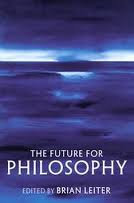by Dave Maier
There has been some interesting recent discussion, both here and elsewhere, about what philosophy is and should be. Here are two shiny pennies from my own purse.
 In the introduction to his recent anthology The Future for Philosophy, Brian Leiter laments that “[p]hilosophy, perhaps more than any other discipline, has been plagued by debates about what the discipline is or ought to be.” This is strong language. To call such debate a “plague” is not simply to regret its occurrence as a necessary evil, but to see it as an alien force, infecting the host body from outside. On this picture, to debate the nature and ends of philosophy is akin to putting the car up on the rack; when this is happening, no progress is being made. If we have to spend all our time figuring out what philosophy is, we'll never get around to actually doing any of it.
In the introduction to his recent anthology The Future for Philosophy, Brian Leiter laments that “[p]hilosophy, perhaps more than any other discipline, has been plagued by debates about what the discipline is or ought to be.” This is strong language. To call such debate a “plague” is not simply to regret its occurrence as a necessary evil, but to see it as an alien force, infecting the host body from outside. On this picture, to debate the nature and ends of philosophy is akin to putting the car up on the rack; when this is happening, no progress is being made. If we have to spend all our time figuring out what philosophy is, we'll never get around to actually doing any of it.
Maybe we should simply shrug the question off. After all, no matter what you said philosophy was, one could always respond “okay, so what these other people do isn't 'philosophy' by your definition; but it's still worthwhile – maybe even more so than what you do under that name.” Coming up with a new name for what we have been calling “philosophy” seems even less pressing. Who cares what something is called, when what is important is whether and how to do it?
However (you knew this was coming), I think these debates can be quite enlightening – if you know what to look for. In any case that is our subject today.
1: Ontic science vs. the linguistic turn
So what is philosophy then? One common answer, usually just assumed but occasionally spelled out, is that philosophers try to discover the basic features of reality, just like science does. However, while physical science determines the nature of observable objects and processes, and thus contingent matters of fact, philosophy concerns itself instead with matters of metaphysical necessity, inquiring into the ultimate entities and structures underlying the world as we encounter it. This conception of philosophy is what Colin McGinn endorses in renaming it “ontic science”: non-empirical inquiry into the real.
On this view, the end result of our inquiry – as it must be if it is to be inquiry at all – is truth (specifically, true doctrines or theories); and the proper method in reaching it is precise, rigorous argument from universally accepted premises to an unambiguous, substantive conclusion. This is naturally easier said than done; and it is no secret that the list of universally accepted philosophical doctrines is – well, let's just say it's not long enough really to count as a “list”. However, I don't think that the lack of universally accepted doctrine shows all by itself that “ontic science”, which we might also call metaphilosophical “dogmatism”, is all wrong; a perfectly good response by my lights would be “well, after all, we Westerners have only been at this for 2500 years – what did you expect?”
If we can't agree, though, then maybe we're doing it wrong; and a natural place to look for the problem is in our instruments: our minds, and in particular, our language. Might these things be systematically distorting our view of reality? This question, along with important formal developments in logic and semantics (I condense and oversimplify here), led at last, in the mid-twentieth century, to what has become known as the “linguistic turn” in analytic philosophy (continental philosophy having broken off some time before).
Read more »
From Bill Clinton to Ellen DeGeneres, celebrities are singing the benefits of a vegan diet. Books that advocate plant-based eating are best sellers. But is eliminating meat and dairy as simple as it sounds?As countless aspiring vegans are discovering, the switch from omnivore to herbivore is fraught with physical, social and economic challenges — at least, for those who don’t have a personal chef. The struggle to give up favorite foods like cheese and butter can be made all the harder by harsh words and eye-rolling from unsympathetic friends and family members. Substitutes like almond milk and rice milk can shock the taste buds, and vegan specialty and convenience foods can cost two to three times what their meat and dairy equivalents do. And new vegans quickly discover that many foods in grocery stores and on restaurant menus have hidden animal ingredients.
